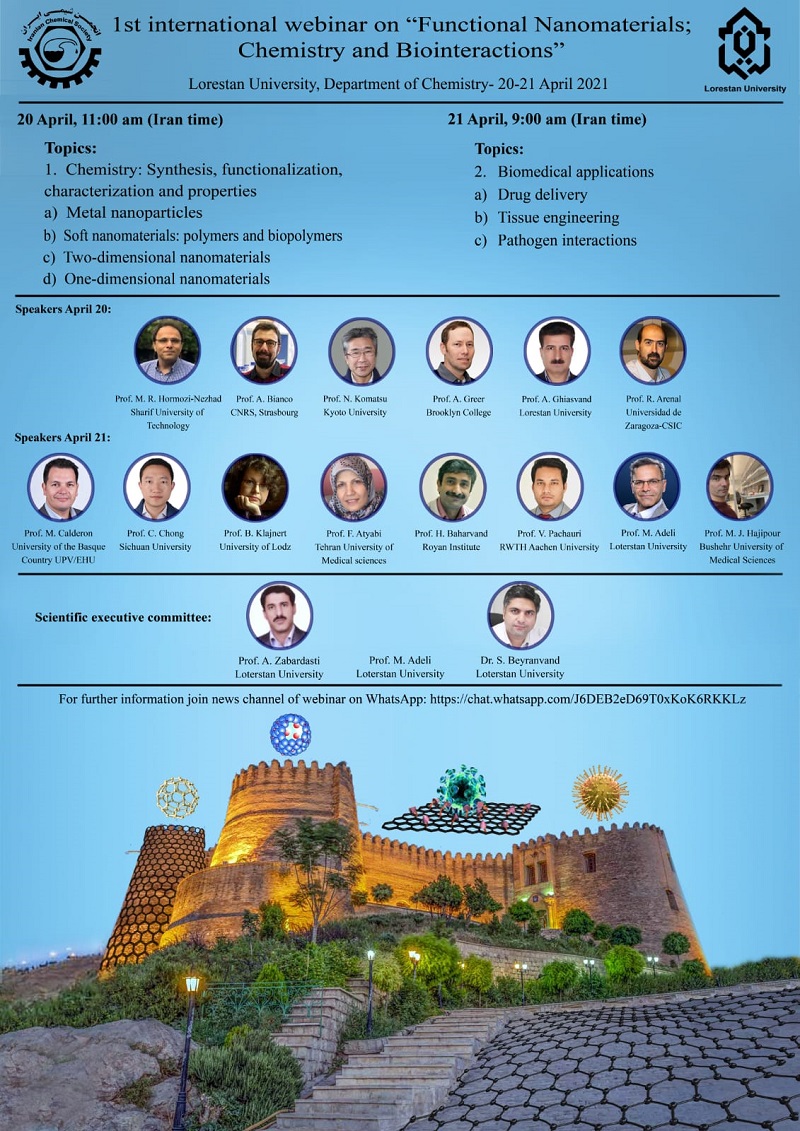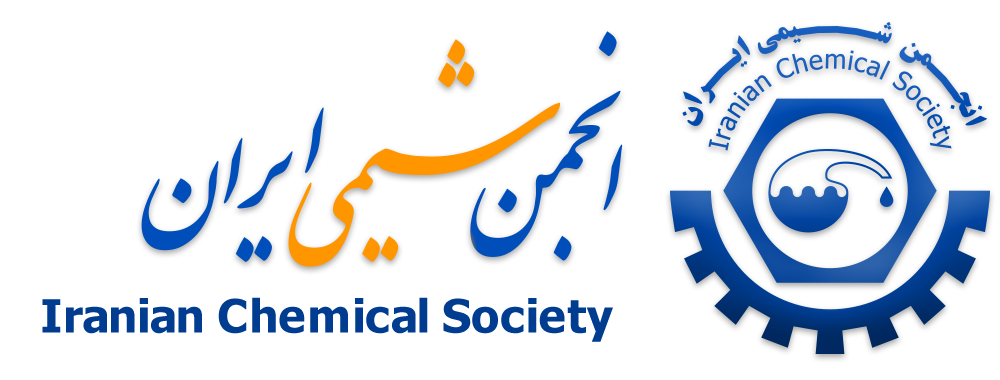1th international webinar on: Functional Nanomaterials; Chemistery and Biointeractions

چهارشنبه اول اردیبهشت۱۴۰۰ ساعت ۱۴:۳۰
جهت کسب اطلاعات بیشتر از وبینار می توانید به گروه واتساپی زیر مراجعه فرمایید:
https://chat.whatsapp.com/J6DEB2eD69T0xKoK6RKKLz
https://chat.whatsapp.com/Lo5hInFj0ADBW7XqHlOvyB
1th international webinar on: Functional Nanomaterials; Chemistery and Biointeractions
I am going to introduce our speakers one by one. This will help you to fix your schedule with the talks in your research area
Prof. Naoki Komatsu
Prof. Naoki Komatsu is one of our speakers from Kyoto University, Japan.
His research focus on two-dimensional nanomaterials and their biomedical applications. He functionalize two-dimensional nanomaterials by polymers to improve their functionality and prossability. He load the functionalized materials with chemotherapeutic agents and targeting ligands to improve localization of drugs in tumors. Laser irradiation and other stimuli factors are used to trigger the release and destroying cancer cells by chemotherapy, photothermal therapy, photodynamic therapy or their synergistic effects.
His talk will be of interest for scientists from chemistry, medicine, pharmacy and veterinary medicine.
Prof. Chong Cheng
One of our speakers is Prof. Chong Cheng. He is very intelligent with hard working and creative characters.
Prof. Chong Cheng is currently a full professor in the department of polymer science at Sichuan University. He obtained his B.Sc. and Ph.D. from Sichuan University. After a research stay at the University of Michigan, Ann Arbor, USA, he joined the Freie Universität Berlin as an AvH research fellow. His current scientific interests include fabricating advanced low-dimensional materials for nanomedicines, antibacterial materials, stem cell scaffolds, and electrocatalysts, especially the cutting-edge applications of metal-organic frameworks. He has published over 100 SCI papers, including Nature Materials, Science Advances, and Advanced Materials.
Prof. Barbara Klajnert
The next speaker I am going to talk about her, is Barbara Klajnert. She is one of the pioneers in the field of dendrimers and their biomedical applications. Her research interest in to study interactions between proteins and macromolecules. Through these interactions, her group try to understand the real dendrimer/protein complexes in the biological mediums. Such interactions and complexes dominate the biological behaviors of dendrimers and other macromolecules. On the other hand interactions between dendrimers and proteins sometimes is strong enough to inhibit fibrillation and treat Alzheimer.
She is interest to play with the functionality of dendrimers and investigate the effect of functionality on the biological behaviors of these macromolecules. Delivery of drugs to the targeted sites by dendrimers is another focus of her research.
I recommend her talk to scientists in medical sciences, chemistry and physic fields.
Prof. Alberto Bianco
I am going to talk about is Prof. Alberto Bianco.
He is from CNRS, Strasbourg. He is active in two-dimensional nanomaterials field, their medical applications and biointeractions. He has worked on functionalization of carbon nanomaterials, in particular graphene, for a long time. He is one of the pioneers in Prato reaction for functionalization of carbon nanomaterials.
The graphene based drug delivery systems and cellular uptake of graphene as well as interactions of this nanomaterial with other biosystems is of his interest.
He is one of the first scientists that has discovered biodegradability of graphene under certain circumstances.
He is a member of editorial board of Carbon Journal.
Dr. Hajipour
Dr. Mohammad Javad Hajipour obtained his Ph. D in 2015 from National Institute of Genetic Engineering and Biotechnology on the development of personalized nanomedicine. Currently, he is head of nanobiotechnology (director of nano-bio group) laboratory at Bushehr University of Medical Sciences and deputy of director for science and technology development at non-communicable disease research center, Tehran University of Medical Sciences. His research is focused on personalized nanomedicine, regenerative medicine, nano-based approaches for treatment of cancer and neurodegenerative diseases, targeted drug delivery to cell/tissue of interest, protein-NP interaction and protein corona formation. For the first time, he introduced the concept of personalized-/disease-specific protein corona and subjected this concept to detect and discriminate neurodegenerative and cancer diseases. He put his effort in discovering hidden factors at the nano-bio interfaces and developing a new strategy to control biological fate/impacts of nanoparticles via tuning protein corona decoration on the nanoparticle surface. Currently he works as senior scientist at Michigan State University USA.
Prof. Arenal
Prof. Arenal is from Zaragoza university.
His research area mostly focuses on the characterization of nanomaterials in sub-nano scale. He is very interest in the surface chemistry and optoelectronic properties of nanomaterials. One of his interests is investigation of the physicochemical properties of nanomaterials and correlation between these properties and the future applications of nanomaterials. I recommend his talk to chemists, physics and related interdisciplinary studies.
He is very bright and on time person. Also he is very effective and active in collaboration.
He will deliver a talk entitled: "Structural and chemical analyses at the atomic scale of low dimensional materials by TEM"
Prof. Dr. Hormozi-Nezhad
Prof. Dr. Hormozi-Nezhad from Sharif University of Technology is one of our speakers.
I know him from 2007 when I was a Post.doc at Sharif University of Technology. His research of interest is the production of different sensors based on functional nanomaterials. He is Director for Research and Technology of Sharif University of technology.
For more information about his talk, I directly share his abstract here:
Nature inspired Nanoplasmonic Sensor Arrays
M Reza Hormozi-Nezhad
Department of Chemistry, Sharif University of Technology, Tehran
hormozi@sharif.edu
Array-based sensing has been inspired from nature’s use of arrays of receptors in the senses of taste and smell. In this so-called “chemical tongue/nose”, each receptor (sensing element) has a semi-selective response to a particular analyte and the specificity of the sensor is accomplished by pattern-based recognition from which distinct response patterns are attained for each analyte. In contrast to the lock-and-key sensing mode which demands highly specific receptors for the detection of each analyte, the sensing elements within array-based probes may have different responses towards different analytes[1]. In other words, in the array strategy, a group of responses are collected from semi-selective sensor elements which produce a distinct pattern for the identification and discrimination of several analytes[1]. Simultaneous determination of various analytes, especially analytes with extremely similar-looking chemical structures, becomes more important when critical decisions have to made, for instance, in the treatment of diseases, food/drug quality control, pollution issues, criminal investigations, explosive detections and many other medical, environmental, industrial, and security concerns. In such cases, employing the unique optical features of plasmonic nanoparticles ( e.g gold and silver nanoparticles) within the differential array-based sensing approach, allows the development of simple, rapid and sensitive nanostructured sensor arrays, capable of effective recognition and discrimination of groups of target species[2-6].
References
1- A. Bigdeli, F. Ghasemi, H. Golmohammadi, S. Abbasi-Moayed, M. A. F. Nejad, N. Fahimi-Kashani, S. Jafarinejad, M. Shahrajabian and M. R. Hormozi-Nezhad, Nanoscale, 2017, 9, 16546–16563.
2- F. Ghasemi, M. R. Hormozi-Nezhad and M. Mahmoudi, Anal. Chim. Acta, 2015, 882, 58–67.
3- N. Fahimi-Kashani, M. R. Hormozi-Nezhad, Anal. Chem. 2016, 88, 8099−8106
4- F. Ghasemi, M. R. Hormozi-Nezhad and M. Mahmoudi, Nanoscale, 2018, 10, 6361–6368.
5- F. Najafzadeh, F. Ghasemi and M. R. Hormozi-Nezhad, Sens.and Actuat. B, 2018, 270, 545–551.
6- M.R. Mirghafouri, S. Abbasi-Moayed, F. Ghasemi, M. R. Hormozi-Nezhad, Anal. Methods, 2020, 12, 5877.
Prof. Hossein Baharvand
Hossein Baharvand is a distinguished Professor, founder, and director of Royan Institute for Stem Cell Biology and Technology. He received his Ph.D. in Cell and Developmental Biology from Khwarizmi University in 2004. For the first time, he generated mouse and human embryonic stem cells (2003) and induced pluripotent stem cells (2008) in Iran. This has enabled his team to pursue many avenues of research into translational research and regenerative medicine. He has focused his research interests on improving the translational research and regenerative medicine mainly through the understanding of Stem Cells and Developmental Biology and Biologically inspired Engineering. Furthermore, he has had several efforts in publicizing stem cell biology in Iran, and in this regard, he with his team established a lab entitled "Stem Cells for all" and a "mobile adventure lab" by an equipped bus. He has also established the “Annual International Summer School” program since 2010.
Prof. Alexander Greer
Professor Alexander Greer is Professor of organic chemistry at the City University of New York (CUNY), Brooklyn College. His research interests are Physical organic chemistry; photooxidation mechanisms; photodynamic therapy, singlet oxygen; preparative-, theoretical- and photochemistry; molecular mechanisms of toxicity; enantiospecific toxicity; antitumor and antifungal compounds; natural products; organism chemical defense mechanisms; natural selection of biological agents; and chemical evolution. He will have a talk in our webinar intitle: Mechanistic Organic Photochemistry: Photogeneration of Reactive Oxygen Intermediates in Solution and on Nanoparticle Interfaces. His talk will be interest for participant in this webinar.
Title of Professor Alexander Greer talk is:
Mechanistic Organic Photochemistry: Photogeneration of Reactive Oxygen Intermediates in Solution and on Nanoparticle Interfaces
Prof. Marcelo Calderon
Prof. Marcelo Calderon is one of our speakers who did his study in Argentina and then moved to Germany for a postdoc.
After a junior professorship in Berlin he moved to San Sebastian in Spain in Polymat Institute.
His research focus on Nanogels and their applications for cancer therapy.
His group look for new ways to produce polymeric networks in nanometer scale and then load these gels with anticancer drugs to deliver them in tumors.
He is highly interest in smart nanogels with the ability of response to stimuli factors like PH and temperature.
The basic science of nanogels production and in vitro and in vivo physicochemical properties of nanogels are the main focuses of his group.
I highly recommend his talk to audience who are interest in nanomaterials and their biomedical applications.
تماس با ما:
دانشگاه لرستان_دانشکده علوم پایه-گروه شیمی
گروه واتساپی اول:
https://chat.whatsapp.com/J6DEB2eD69T0xKoK6RKKLz
گروه واتساپی دوم:
https://chat.whatsapp.com/Lo5hInFj0ADBW7XqHlOvyB
